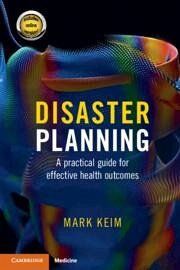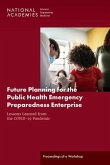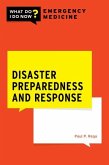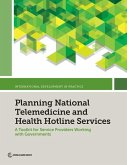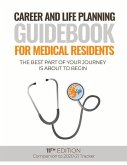- Broschiertes Buch
- Merkliste
- Auf die Merkliste
- Bewerten Bewerten
- Teilen
- Produkt teilen
- Produkterinnerung
- Produkterinnerung
A practical step-by-step guide for writing, implementing, and evaluating plans that address any disaster, however unexpected.
Andere Kunden interessierten sich auch für
![International Disaster Nursing International Disaster Nursing]() International Disaster Nursing131,99 €
International Disaster Nursing131,99 €![Future Planning for the Public Health Emergency Preparedness Enterprise Future Planning for the Public Health Emergency Preparedness Enterprise]() National Academies of Sciences Engineering and MedicineFuture Planning for the Public Health Emergency Preparedness Enterprise26,99 €
National Academies of Sciences Engineering and MedicineFuture Planning for the Public Health Emergency Preparedness Enterprise26,99 €![Oxford American Handbook of Disaster Medicine Oxford American Handbook of Disaster Medicine]() Oxford American Handbook of Disaster Medicine103,99 €
Oxford American Handbook of Disaster Medicine103,99 €![Disaster Preparedness and Response Disaster Preparedness and Response]() Paul P RegaDisaster Preparedness and Response68,99 €
Paul P RegaDisaster Preparedness and Response68,99 €![The Kingdom of the Mind: How to Promote Intelligent Living and Avert Mental Disaster The Kingdom of the Mind: How to Promote Intelligent Living and Avert Mental Disaster]() James Mortimer KenistonThe Kingdom of the Mind: How to Promote Intelligent Living and Avert Mental Disaster25,99 €
James Mortimer KenistonThe Kingdom of the Mind: How to Promote Intelligent Living and Avert Mental Disaster25,99 €![Planning National Telemedicine and Health Hotline Services Planning National Telemedicine and Health Hotline Services]() World BankPlanning National Telemedicine and Health Hotline Services32,99 €
World BankPlanning National Telemedicine and Health Hotline Services32,99 €![Career and Life Planning Guidebook for Medical Residents: The Best Part of Your Journey Is about to Begin Career and Life Planning Guidebook for Medical Residents: The Best Part of Your Journey Is about to Begin]() Todd SkertichCareer and Life Planning Guidebook for Medical Residents: The Best Part of Your Journey Is about to Begin79,99 €
Todd SkertichCareer and Life Planning Guidebook for Medical Residents: The Best Part of Your Journey Is about to Begin79,99 €-
-
-
A practical step-by-step guide for writing, implementing, and evaluating plans that address any disaster, however unexpected.
Hinweis: Dieser Artikel kann nur an eine deutsche Lieferadresse ausgeliefert werden.
Hinweis: Dieser Artikel kann nur an eine deutsche Lieferadresse ausgeliefert werden.
Produktdetails
- Produktdetails
- Verlag: Cambridge University Press
- Seitenzahl: 228
- Erscheinungstermin: 20. Januar 2022
- Englisch
- Abmessung: 231mm x 206mm x 13mm
- Gewicht: 318g
- ISBN-13: 9781009004220
- ISBN-10: 1009004220
- Artikelnr.: 61935447
- Herstellerkennzeichnung
- Libri GmbH
- Europaallee 1
- 36244 Bad Hersfeld
- gpsr@libri.de
- Verlag: Cambridge University Press
- Seitenzahl: 228
- Erscheinungstermin: 20. Januar 2022
- Englisch
- Abmessung: 231mm x 206mm x 13mm
- Gewicht: 318g
- ISBN-13: 9781009004220
- ISBN-10: 1009004220
- Artikelnr.: 61935447
- Herstellerkennzeichnung
- Libri GmbH
- Europaallee 1
- 36244 Bad Hersfeld
- gpsr@libri.de
Dr Mark Keim is the CEO of DisasterDoc LLC, an international firm specializing in consultation, education and research related to public health emergencies. He is also an adjunct Professor at Emory Rollins School of Public Health, Atlanta; and Faculty at BIDMC Harvard Medical School, Boston, on the Disaster Medicine Fellowship program.
Preface
Materials covered
How to use this book
How to use the website materials
Acknowledgements
Part I. Introduction: 1. What is planning?
2. What is disaster planning?
3. Planning as component of preparedness
4. A capability-based approach for emergency preparedness
Part II. The Principles Of Emergency Operations Planning: 5. Eight principles of effective planning
6. The O2C3 approach to effective planning
7. Operational planning
8. Objective based planning
9. Capability-based planning
10. Consensus-based planning
11. Compliance with norms, plans and regulations
Part III. The Practice Of Emergency Operations Planning: 12. The ADEPT(TM) planning system
13. The SOARR(TM) format for plan organization
14. The ADEPT(TM) planning wheel
14. Preparation for plan writing
Part IV. The Process Of Emergency Operations Planning: 16. Planning assumptions
17. Risk assessment
18. Creating plans
19. Gap analysis
20. Plan implementation
21. Plan sharing
Part V. The Quality Of Emergency Operations Planning: 22. Plan monitoring and evaluation
23. Plan improvement
24. Planning pitfalls
25. The future of disaster planning
Part VI. Appendices
Appendix A: Epilogue
Appendix B: Definition of Key Terms
Appendix C: ADEPT Example Plan
Part VII. References.
Materials covered
How to use this book
How to use the website materials
Acknowledgements
Part I. Introduction: 1. What is planning?
2. What is disaster planning?
3. Planning as component of preparedness
4. A capability-based approach for emergency preparedness
Part II. The Principles Of Emergency Operations Planning: 5. Eight principles of effective planning
6. The O2C3 approach to effective planning
7. Operational planning
8. Objective based planning
9. Capability-based planning
10. Consensus-based planning
11. Compliance with norms, plans and regulations
Part III. The Practice Of Emergency Operations Planning: 12. The ADEPT(TM) planning system
13. The SOARR(TM) format for plan organization
14. The ADEPT(TM) planning wheel
14. Preparation for plan writing
Part IV. The Process Of Emergency Operations Planning: 16. Planning assumptions
17. Risk assessment
18. Creating plans
19. Gap analysis
20. Plan implementation
21. Plan sharing
Part V. The Quality Of Emergency Operations Planning: 22. Plan monitoring and evaluation
23. Plan improvement
24. Planning pitfalls
25. The future of disaster planning
Part VI. Appendices
Appendix A: Epilogue
Appendix B: Definition of Key Terms
Appendix C: ADEPT Example Plan
Part VII. References.
Preface
Materials covered
How to use this book
How to use the website materials
Acknowledgements
Part I. Introduction: 1. What is planning?
2. What is disaster planning?
3. Planning as component of preparedness
4. A capability-based approach for emergency preparedness
Part II. The Principles Of Emergency Operations Planning: 5. Eight principles of effective planning
6. The O2C3 approach to effective planning
7. Operational planning
8. Objective based planning
9. Capability-based planning
10. Consensus-based planning
11. Compliance with norms, plans and regulations
Part III. The Practice Of Emergency Operations Planning: 12. The ADEPT(TM) planning system
13. The SOARR(TM) format for plan organization
14. The ADEPT(TM) planning wheel
14. Preparation for plan writing
Part IV. The Process Of Emergency Operations Planning: 16. Planning assumptions
17. Risk assessment
18. Creating plans
19. Gap analysis
20. Plan implementation
21. Plan sharing
Part V. The Quality Of Emergency Operations Planning: 22. Plan monitoring and evaluation
23. Plan improvement
24. Planning pitfalls
25. The future of disaster planning
Part VI. Appendices
Appendix A: Epilogue
Appendix B: Definition of Key Terms
Appendix C: ADEPT Example Plan
Part VII. References.
Materials covered
How to use this book
How to use the website materials
Acknowledgements
Part I. Introduction: 1. What is planning?
2. What is disaster planning?
3. Planning as component of preparedness
4. A capability-based approach for emergency preparedness
Part II. The Principles Of Emergency Operations Planning: 5. Eight principles of effective planning
6. The O2C3 approach to effective planning
7. Operational planning
8. Objective based planning
9. Capability-based planning
10. Consensus-based planning
11. Compliance with norms, plans and regulations
Part III. The Practice Of Emergency Operations Planning: 12. The ADEPT(TM) planning system
13. The SOARR(TM) format for plan organization
14. The ADEPT(TM) planning wheel
14. Preparation for plan writing
Part IV. The Process Of Emergency Operations Planning: 16. Planning assumptions
17. Risk assessment
18. Creating plans
19. Gap analysis
20. Plan implementation
21. Plan sharing
Part V. The Quality Of Emergency Operations Planning: 22. Plan monitoring and evaluation
23. Plan improvement
24. Planning pitfalls
25. The future of disaster planning
Part VI. Appendices
Appendix A: Epilogue
Appendix B: Definition of Key Terms
Appendix C: ADEPT Example Plan
Part VII. References.

